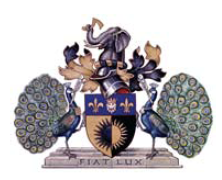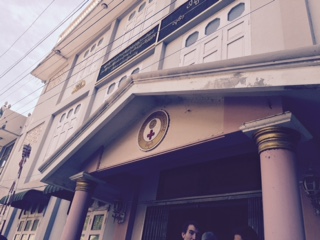
Ophthalmology is a clinical and surgical specialty within medicine that deals with the diagnosis and treatment of eye disorders. A former term is oculism.

Moorfields Eye Hospital is a specialist National Health Service (NHS) eye hospital in Finsbury in the London Borough of Islington in London, England run by Moorfields Eye Hospital NHS Foundation Trust. Together with the UCL Institute of Ophthalmology, which is adjacent to the hospital, it is the oldest and largest centre for ophthalmic treatment, teaching and research in Europe.
The Lions Eye Institute (LEI) is an Australian medical research institute affiliated with the University of Western Australia. It was established in 1983 with support of the Lions Clubs of Western Australia and headquartered in the Perth suburb of Nedlands, Western Australia. The LEI is a not-for-profit centre of excellence that combines an ophthalmic clinic with scientific discovery developing techniques for the prevention of blindness and the reduction of pain from blinding eye conditions.

Sankara Nethralaya is a non-profit missionary institution for ophthalmic care headquartered in Chennai, India.
Suseela Prabhakaran is an Indian ophthalmologist and chief ophthalmic surgeon at Divya Prabha Eye Hospital in Trivandrum, India. She started her career as a lecturer in ophthalmology in the Department of Medical Education at the state government of Kerala.
Geoffrey Rose BSc MBBS MS DSc MRCP FRCS FRCOphth is an English ophthalmologist and Past-President of both the British OculoPlastic Surgery Society (BOPSS) and the European Society of Ophthalmic Plastic and Reconstructive Surgeons (ESOPRS).
Sheraz Daya is a British ophthalmologist. Daya founded the Centre for Sight in 1996, and works in stem-cell research and sight restoration and correction surgery.
Gerard Sutton is an Australian ophthalmic surgeon and ophthalmologist in Australia and New Zealand. His specialty is laser vision correction, cataract and lens surgery, and corneal transplantation.
Tilganga Institute of Ophthalmology, formerly called the Tilganga Eye Centre, in Nepal is the implementing body of the Nepal Eye Program, a non-profit, community based, non-government organization launched in 1992. It was founded in part by ophthalmologist and cataract surgeon Sanduk Ruit. The current facility was opened in 1994. The World Health Organization recognized Tilganga Institute of Ophthalmology as a WHO Collaboration Centre of Ophthalmology in 2019. In Nepal, it is the second institute, and first institute in the field of ophthalmology to receive this designation. It provides various speciality services of Ophthalmology.
The Himalayan Cataract Project (HCP) was created in 1995 by Dr. Geoffrey Tabin and Dr. Sanduk Ruit with a goal of establishing a sustainable eye care infrastructure in the Himalaya. HCP empowers local doctors to provide ophthalmic care through skills-transfer and education. From its beginning, HCP responds to a pressing need for eye care in the Himalayan region. With programs in Nepal, Ethiopia, Ghana, Bhutan and India they have been able to restore sight to over 1.4 million people since 1995.

The Royal College of Ophthalmologists, founded in 1988, is an independent professional body and one of the Medical Royal Colleges. They set the standards and examinations for medical doctors aiming to become ophthalmologists, and provide surgical skills training, as well as services to those who have completed their training.
Noshir Minoo Shroff is an Indian ophthalmologist notable for pioneering intraocular lens implantation surgery in India. He was awarded the Padma Bhushan in 2010 by the Indian government for his services to medicine.
Jeewan Singh Titiyal is an Indian ophthalmologist, credited with the first live cornea transplant surgery by an Indian doctor. He was honoured by the Government of India, in 2014, by bestowing on him the Padma Shri, the fourth highest civilian award, for his services to the field of medicine.

Seyed Hassan Ghazizadeh Hashemi is an ophthalmologist and full professor at Tehran University of Medical Sciences, as well as the head and founder of the Noor Ophthalmology Complex.

The Wachet Jivitadana Sangha Hospital is a monastic hospital located in Wachet, Myanmar. It was founded on 20 October 1984 by Sayadaw U Lakkhana, an abbot of the Kyaswa Gyaug Monastery in Sagaing, using donations from monks, nuns, and others in the village of Wachet.

Berthold Seitz is a German ophthalmologist, professor and director of the Department of Ophthalmology at the Saarland University Medical Center in Homburg, Saarland. He is known for his scientific contributions in the fields of cornea transplantation, cataract surgery and artificial lens-calculation after refractive corneal surgery as well as techniques of amniotic membrane transplantation and its histological integration patterns in the cornea.
Tony Fernandez is an Indian ophthalmologist, noted for his contributions in founding and fostering an eye care centre at Little Flower Hospital, Angamaly, thereby elevating the hospital from the level of a medical dispensary into an 800-bedded hospital. He founded the first eye bank in the private sector in Kerala and is a former president of the All India Ophthalmological Society. He has delivered many award orations including the Dr Sriniavasa Rao Memorial Oration Award (1995) of the Karnataka Ophthalmic Society and has initiated a social project, Kazhcha-Vision 2020, in association with South Indian film actor, Mammootty, for providing free cataract treatment to financially compromised people of Kerala. The Government of India awarded him the fourth highest civilian honour of the Padma Shri, in 2008, for his contributions to medicine. Kerala Society of Ophthalmic Surgeons have instituted an award, Padmasree Dr. Tony Fernandez Award, in his honour, awarded annually to the best video on ophthalmology.
Burkhard Dick is a German ophthalmologist who has specialized in refractive and cataract surgery. With his many contributions to the scientific literature on this topic, he is considered one of the pioneers of employing the femtosecond laser in cataract surgery. In the "Power List 2024" by the publication The Ophthalmologist, Burkhard Dick was listed among the world's most 100 most influential ophthalmologists.
Allon Barsam is a London-based ophthalmologist specializing in cataract surgery, refractive surgery and corneal and external eye disease. Barsam carried out the first human treatments of microwave keratoplasty.
Noemi Lois is a Clinical Professor of Ophthalmology at Queen's University Belfast and an Honorary Consultant Ophthalmologist and Vitreoretinal Surgeon at the Belfast Health and Social Care Trust.







